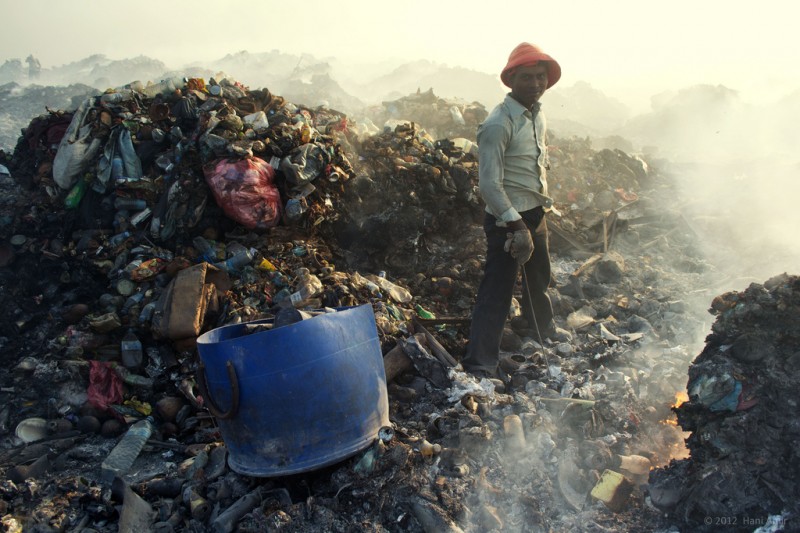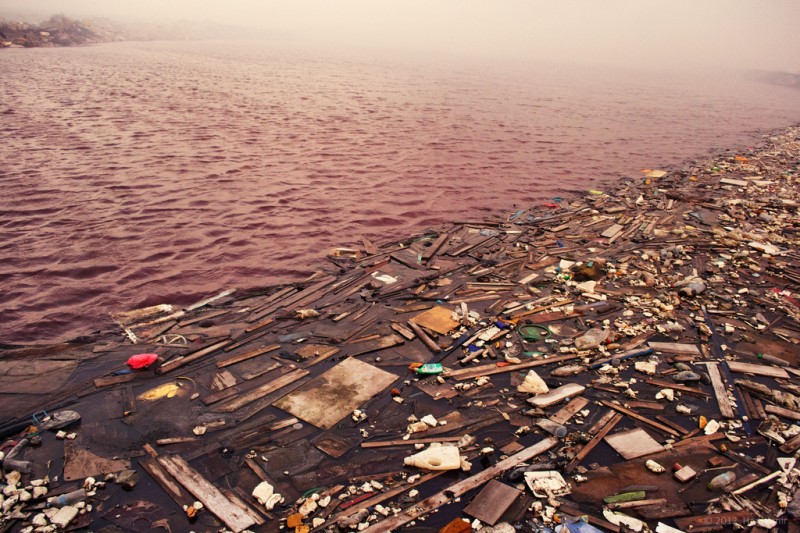 |
| Thilafushi Kuni Gondu - This is where they burn the garbage in paradise. Image from Flickr by Hani Amir. CC BY-NC-ND |
But there's an ugly consequence of all those visitors, along with the Maldives' own 395,000 residents: the combined trash accumulated is a headache for the small country.
To deal with the problem, the government decided in December 1991 to use a separate island as the final destination for the huge amount of waste produced by the tourism industry. Thilafushi, nicknamed 'Rubbish Island', originally was a lagoon called ‘Thilafalhu’ with a length of 7 kilometres and a width of 200 metres at the shallowest regions. Huge pits were dug, and waste was deposited into the middle of the pit, which was topped off with a layer of construction debris and then uniformly levelled with white sand.
welcome to the maldives! #thilafushi #rubbishisland #müllinsel pic.twitter.com/W7khANOFV5
— nika (@kollerannika) July 11, 2014
An average of 330 tonnes of rubbish are brought to Thilafushi every day, most of which are from Malé. At one point, more than 31,000 truckloads of garbage were being transported to Thilafushi annually. Open-air burning of garbage is also practiced here.
Anyone concerned of what the Locals and Foriegners working in #Thilafushi inhales? Unknown stuff burned pic.twitter.com/r7ksUq2rwp
— Ari[p]h ™ (@Aariphh) August 17, 2013
Today, Thilafushi has a landmass of more than 0.43 km2, which is leased to industrial activities such as boat manufacturing, cement packing, methane gas bottling and various large-scale warehousing.The blog of environmental organisation Bluepeace wrote that used batteries, asbestos, lead and other potentially hazardous waste mixed with the municipal solid wastes in Thilafushi island are seeping into the water and creating serious ecological and health problems in the Maldives. However, the concerns have never materialized into a campaign by local activists.
Do you think Thilafushi is a mistake? Imagine the state of the rubbish in 20 yrs time? Can our sea be saved? pic.twitter.com/Mw7YXS17OS
— Leela (@leelamad) April 13, 2014
Mordy at collaborative travel project Atlas Obscura described the problem:Commercial activity along with indiscriminate dumping has brought an abundance of toxic materials to the lagoon - broken oil drums, asbestos, lead, and other noxious metals mix in with daily household garbage items creating a noxious sludge. There is little around the island that goes unpolluted as harmful substances seep into the water and smoke from burning waste floods the air.
 |
| Thilafushi island - where garbage seeps into the ocean. Image from Flickr by Hani Amir. CC BY-NC-ND |
The government temporarily banned rubbish dumping on the island in December 2011 after a surge in waste floating in the island's lagoon and drifting out to sea. But still now all the garbage from Malé ends up there.
Alibeyya, a commenter on an article on local news site Minivan, pointed to the crux of the problem:
The delicate environment of Maldives is in need of a responsible waste management system. It is a big challenge given the geographical situation where each island including resorts must manage its own waste. [..] The resorts should be able to contain to get rid of their waste without having to dump to Thialfushi lagoon.In early 2013 there were reports that Maldives’ waste management is being hampered by local politics and lack of funding. Amidst local reports of illegal dumping of wastes in Thilafushi, there was huge confusion over the responsibility for the management of garbage dumping. The Thilafushi management was transferred to the Malé City Council (MCC) in 2010 and a contract was signed in 2011 with the Indian-based company Tatva Global Renewable Energy to rehabilitate the island and manage the garbage problem.
But the deal never was implemented due to bureaucracy and political interference and recently it was cancelled, making the future of Thilafushi uncertain.
Abdullah Faraz writes in an opinion piece in Minivan News:
The first point to note is that underneath all the political rhetoric and maneuvering lies a real issue that affects many lives – the public health hazard, teachers and students being hospitalised, closing of schools, the smoke, the stench etc.What is for certain: a new jail soon is set to be opened on Thilafushi island next month.
The public has a right to feel disaffected by this crisis, and is indignant and up in arms with good cause.
The second point to note is though this is a manufactured crisis; there is no inherent direction to which this raw emotional energy of the public may flow.
"@vaavu: Thilafushi jail which can accommodate 100 prisoners to open next month http://t.co/SPTCPwDWNU via @vaavu"
— Shumba Gong (@ShumbaGong) octubre 20, 2014
Additional input by Saffah Faroog
The post was also published in Global Voices Online.
























0 comments:
Post a Comment